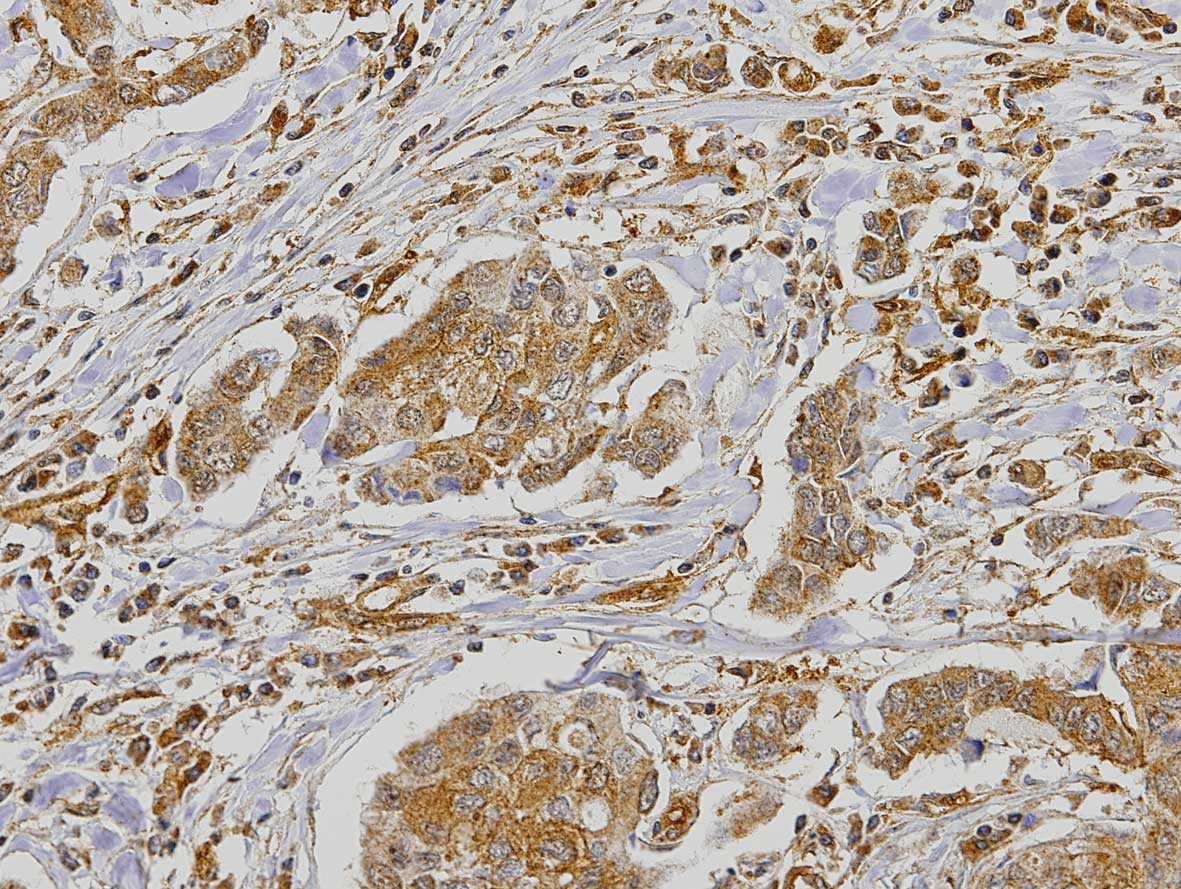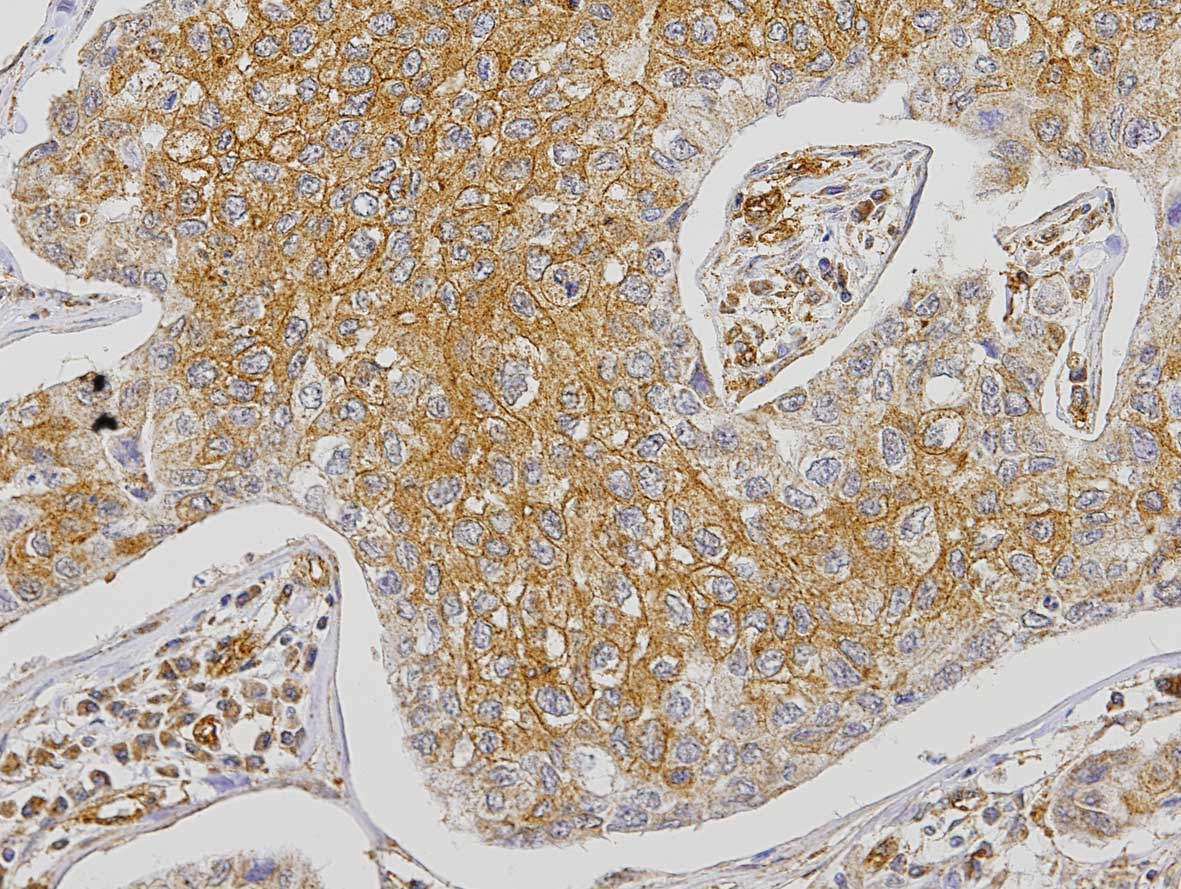|
1.
|
J FerlayHR ShinF BrayD FormanC MathersDM
ParkinEstimates of worldwide burden of cancer in 2008: GLOBOCAN
2008Int J Cancer12728932917201010.1002/ijc.2551621351269
|
|
2.
|
B WeigeltJS Reis-FilhoHistological and
molecular types of breast cancer: is there a unifying taxonomy?Nat
Rev Clin Oncol6718730200910.1038/nrclinonc.2009.16619942925
|
|
3.
|
B WeigeltHM HorlingsB KreikeRefinement of
breast cancer classification by molecular characterization of
histological special typesJ
Pathol216141150200810.1002/path.240718720457
|
|
4.
|
D HanahanRA WeinbergHallmarks of cancer:
the next
generationCell144646674201110.1016/j.cell.2011.02.01321376230
|
|
5.
|
L PusztaiCurrent status of prognostic
profiling in breast
cancerOncologist13350360200810.1634/theoncologist.2007-021618448548
|
|
6.
|
YJ YinZ SalahM MaozOncogenic
transformation induces tumour angiogenesis: a role for PAR1
activationFASEB J17163174200310.1096/fj.02-0316com12554695
|
|
7.
|
SF WinterVD AcevedoRD GangulaConditional
activation of FGFR1 in the prostate epithelium induces angiogenesis
with concomitant differential regulation of Ang-1 and
Ang-2Oncogene2648974907200710.1038/sj.onc.1210288
|
|
8.
|
A AgarwalL CovicLM SevignyTargeting a
metalloprotease-PAR1 signaling system with cell-penetrating
pepducins inhibits angiogenesis, ascites, and progression of
ovarian cancerMol Cancer
Ther727462757200810.1158/1535-7163.MCT-08-017718790755
|
|
9.
|
TK VuDT HungVI WheatonSR CoughlinMolecular
cloning of a functional thrombin receptor reveals a novel
proteolytic mechanism of receptor
activationCell6410571068199110.1016/0092-8674(91)90261-V1672265
|
|
10.
|
PJ O’BrienN PrevostM MolinoMK HollingerMJ
WoolkalisDS WoulfeLF BrassThrombin responses in human endothelial
cells. Contributions from receptors other than PAR1 include the
transactivation of PAR2 by thrombin-cleaved PAR1J Biol
Chem2751350213509200010788464
|
|
11.
|
A BoireL CovicA AgarwalPAR1 is a matrix
metalloprotease-1 receptor that promotes invasion and
tumourigenesis of breast cancer
cellsCell120303313200510.1016/j.cell.2004.12.01815707890
|
|
12.
|
S BassusO HerkertN KronemannThrombin
causes vascular endothelial growth factor expression in vascular
smooth muscle cells: role of reactive oxygen speciesArterioscler
Thromb Vasc Biol2115501555200110.1161/hq0901.09514811557687
|
|
13.
|
M DuarteV KolevR SoldiThrombin induces
rapid PAR1-mediated non-classical FGF1 releaseBiochem Biophys Res
Commun350604609200610.1016/j.bbrc.2006.09.10717027650
|
|
14.
|
P DelafontaineA AnwarH LouL KuG-protein
coupled and tyrosine kinase receptors: evidence that activation of
the insulin-like growth factor I receptor is required for thrombin
induced mitogenesis of rat aortic smooth muscle cellsJ Clin
Invest97139145199610.1172/JCI118381
|
|
15.
|
BH RauchE MilletteRD KenagyThrombin- and
factor Xa-induced DNA synthesis is mediated by transactivation of
fibroblast growth factor receptor-1 in human vascular smooth muscle
cellsCirc
Res94340345200410.1161/01.RES.0000111805.09592.D814670838
|
|
16.
|
NA HernandezE CorreaEP AvilaPAR1 is
selectively over expressed in high grade breast cancer patients: a
cohort studyJ Transl Med747200910.1186/1479-5876-7-4719538737
|
|
17.
|
MR D’AndreaCK DerianRJ SantulliP
Andrade-GordonDifferential expression of protease activated
receptors-1 and -2 in stromal fibroblasts of normal, benign, and
malignant human tissuesAm J Pathol15820312041200111395381
|
|
18.
|
KL SchwertfegerFibroblast growth factors
in development and cancer: insights from the mammary and prostate
glandsCurr Drug
Targets10632644200910.2174/13894500978868041919601767
|
|
19.
|
BE WelmKW FreemanM ChenInducible
dimerization of FGFR1: development of a mouse model to analyze
progressive transformation of the mammary glandJ Cell
Biol157703714200210.1083/jcb.20010711912011115
|
|
20.
|
A MarinhoR SoaresJ FerroAngiogenesis in
breast cancer is related to age but not to other prognostic
parametersPathol Res
Pract193267273199710.1016/S0344-0338(97)80003-99258952
|
|
21.
|
JD BrentonLA CareyAA AhmedC
CaldasMolecular classification and molecular forecasting of breast
cancer: ready for clinical application?J Clin
Oncol2373507360200510.1200/JCO.2005.03.384516145060
|
|
22.
|
J ParedesAL CorreiaAS RibeiroBreast
carcinomas that co-express E- and P-cadherin are associated with
p120-catenin cytoplasmic localisation and poor patient survivalJ
Clin Pathol61856862200810.1136/jcp.2007.05270418381381
|
|
23.
|
J ParedesF MilaneziL ViegasP-cadherin
expression is associated with high-grade ductal carcinoma in situ
of the breastVirchows
Arch4401621200210.1007/s00428010048711942571
|
|
24.
|
E YangA BoireA AgarwalBlockade of PAR1
signaling with cell-penetrating pepducins inhibits Akt survival
pathways in breast cancer cells and suppresses tumour survival and
metastasisCancer
Res6962236231200910.1158/0008-5472.CAN-09-018719622769
|
|
25.
|
S Even-RamB UzielyP CohenThrombin receptor
over-expression in malignant and physiological invasion
processesNat Med4909914199810.1038/nm0898-9099701242
|
|
26.
|
JC Bourdonp53 and its isoforms in cancerBr
J Cancer97277282200710.1038/sj.bjc.660388617637683
|
|
27.
|
K SuyamaI ShapiroM GuttmanRB HazanA
signaling pathway leading to metastasis is controlled by N-cadherin
and the FGF receptorCancer
Cell2301314200210.1016/S1535-6108(02)00150-212398894
|
|
28.
|
W XianKL SchwertfegerT Vargo-GogolaJM
RosenPleiotropic effects of FGFR1 on cell proliferation, survival,
and migration in a 3D mammary epithelial cell modelJ Cell
Biol171663673200510.1083/jcb.20050509816301332
|
|
29.
|
JS Reis-FilhoPT SimpsonNC TurnerFGFR1
emerges as a potential therapeutic target for lobular breast
carcinomasClin Cancer
Res1266526662200610.1158/1078-0432.CCR-06-116417121884
|
|
30.
|
S Elbauomy ElsheikhAR GreenMB LambrosFGFR1
amplification in breast carcinomas: a chromogenic in situ
hybridisation analysisBreast Cancer Res9R23200717397528
|
|
31.
|
R GroseC DicksonFibroblast growth factor
signaling in tumourigenesisCytokine Growth Factor
Rev16179186200510.1016/j.cytogfr.2005.01.00315863033
|
|
32.
|
J HasanR ByersGC JaysonIntratumoural
microvessel density in human solid tumoursBr J
Cancer8615661577200210.1038/sj.bjc.660031512085206
|
|
33.
|
N LopesB SousaD VieiraVessel density
assessed by endoglin expression in breast carcinomas with different
expression
profilesHistopathology55594599200910.1111/j.1365-2559.2009.03417.x19912365
|
















